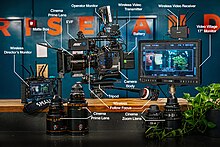A digital movie camera for digital cinematography is a motion picture camera that captures footage digitally rather than physical film, which shoots on film stock. Different digital movie cameras output a variety of different acquisition formats. Cameras designed for domestic use have also been used for low-budget independent productions.

Since the 2000s, digital movie cameras have become the dominant type of camera in the motion picture industry.[1]
Types
editProfessional cameras
editThere are a number of movie cameras on the market designed specifically for high-end digital cinematography use. These cameras typically offer relatively large sensors, selectable frame rates, recording options with low compression ratios or, in some cases, no compression, and the ability to use high-quality optics. Some of the cameras are expensive, and some are only available to rent. Most digital movie cameras are heavily accessorized once used on a film set.[2]
Some of the most used professional digital movie cameras include:
- Arri Alexa
- Blackmagic URSA
- Blackmagic Pocket Cinema Cameras
- Canon Cinema EOS
- Panavision Genesis
- Panasonic VariCam
- Red Epic
- Red Scarlet
- Red One
- Sony CineAlta
Prosumer and consumer cameras
editIndependent movie-makers have also pressed low-cost consumer and hybrid prosumer cameras into service for digital cinematography. Though image quality is typically much lower than what can be produced with professional digital cinematography cameras, the technology has steadily improved, most significantly in the last several years with the arrival of high-definition cameras in this market. These inexpensive cameras are limited by their relatively high compression ratios, their small sensors, and the quality of their optics. Many also have integrated lenses which cannot be changed.
Resolution
editStandard definition
editMiniDV was the predominant standard definition consumer video acquisition format in the early 2000s. Steven Soderbergh used the Canon XL-1s MiniDV camera while shooting Full Frontal. The Danny Boyle directed British horror film, 28 Days Later was also shot on MiniDV using the Canon XL-1, albeit with traditional Panavision 35mm film lenses. One of the first MiniDV cameras used on a feature film was the Sony VX-1000, which was used to shoot Spike Lee's Bamboozled.
In 2002, Panasonic released the AG-DVX100, which was the first affordable camcorder to support progressive scan at 24 frames per second on its 60Hz version, duplicating the motion characteristics of film and allowing for easier transfers to film.
High definition
editSony, JVC and Canon brought high-definition video acquisition to the consumer and prosumer markets with the HDV format. HDV cameras sold with a wide range of capabilities. Many support progressive shooting modes, and some have sensors with full 1920x1080 resolution (though the HDV format itself can only record 1440x1080 in non-square pixels, and DVCPRO HD only records at 1280x1080 or 960x720). In addition, some Canon and JVC HDV camcorders have the ability to use high-quality interchangeable lenses, rather than the fixed lenses that are included with most prosumer cameras.
4K & The DSLR Revolution
editThe resolution and form factor revolution came with the RED ONE in 2007, a camera built around a modified APS-C sensor by the Red Digital Cinema company and embraced by celebrity filmmakers like Peter Jackson. It shot in 4K at a quality comparable to 35mm film.[3]
Filmmakers were looking for cameras that were superior to the camcorders they had been working with, yet more affordable than the RED or shooting on film. The Canon EOS 5D Mark II was released in 2008, a "full-frame" format HDSLR camera capable of both photos and recording 1080p video at 24, 25 or 30 frames per second, with a file size limit of 4 GB. Movie makers pressed this camera into service as a low-cost way to shoot high-quality motion footage, which reigned in the "DSLR Revolution"[4], most notably with filmmaker Vincent Laforet getting advance access to the camera and shooting his short film "Reverie" with the 5D Mk II out of a helicopter at night, a feat not previously possible with lower-sensitivity film stock[5]. In 2012, Shane Hurlbut shot the big-budget blockbuster Act of Valor on these cameras, cementing their role in being taken seriously as a platform and form factor[6]. The Canon EOS 7D is an APS-C HDSLR that was used to shoot the independent horror film Marianne[7] and Sound of My Voice.[8] Both cameras have been used together to shoot point-of-view (POV) action scenes in The Avengers due to the cameras being relatively cheap and small and, therefore, easily used to shoot different angles in tight locations.[9][10]
Current cinema cameras can shoot up to 16K as of 2024, albeit most camera and monitoring systems still group around the 4K standard.[11]
List of digital movie cameras
editSee also
editReferences
edit- ^ Siede, Caroline (23 August 2018). "Maybe the war between digital and film isn't a war at all". AV Club. Retrieved 14 January 2019.
In 2017, 92 percent of films were shot on digital.
- ^ camerarentalsnyc (2024-08-04). "What are the Components of a Camera Rental Package?". Camera Rentals NYC. Retrieved 2024-09-13.
- ^ "REVIEW: RED ONE Digital Cinema Camera". Studio Daily. 2007-11-01. Retrieved 2024-09-14.
- ^ Denning, Roland. "How the DSLR revolution changed the way we see cameras - part 1". www.redsharknews.com. Retrieved 2024-09-14.
- ^ buchanan, matt (2010-07-06). "A Helicopter Ride With the King of DSLR Video". Gizmodo. Retrieved 2024-09-14.
- ^ ASC, Shane Hurlbut (2012-03-05). "Filmmakers Academy Premium Education". Filmmakers Academy. Retrieved 2024-09-14.
- ^ Filip, Tegsdedt. "DSLR Feature Film List". Archived from the original on 12 November 2020. Retrieved 27 May 2011.
- ^ "Sound of My Voice (2011) - IMDb". IMDb.
- ^ 'The Avengers' Made Use of Canon dSLRs for POV Action Shots, Steves Digicams
- ^ Canon Highlights Use of EOS DSLRs in “Marvel’s The Avengers”, The-Digital-Picture.com
- ^ "4K Video vs the Known Resolution Galaxy (SD, HD, 2K, 5K, 8K, 16K, 32K)". Devin Super Tramp. Retrieved 2024-09-14.